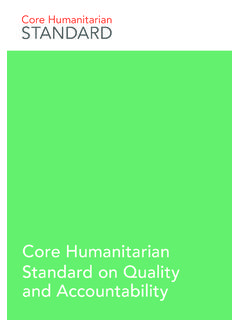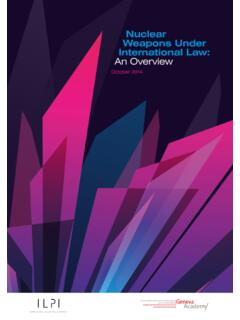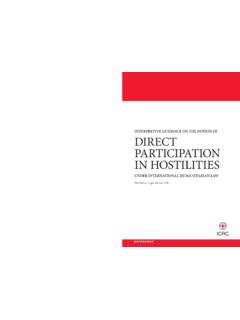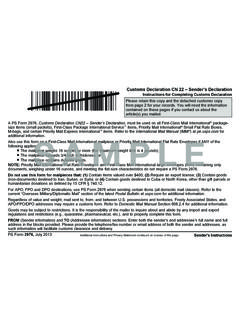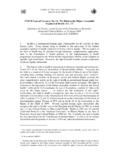Transcription of MULTI-ANNUAL INDICATIVE PROGRAMME Thematic …
1 1 MULTI-ANNUAL INDICATIVE PROGRAMME NDICI- Global Europe Thematic PROGRAMME on Peace, Stability and Conflict Prevention 2021 - 2027 The Neighbourhood, Development and international Cooperation Instrument (NDICI Global Europe) includes provisions that enable the European Union (EU) to fund actions to promote peace, stability and conflict prevention. In accordance with Article 15 of the NDICI-GE Regulation1, the 2021-2027 Peace, Stability and Conflict Prevention Thematic PROGRAMME shall be accompanied by a Multiannual INDICATIVE PROGRAMME (MIP) which shall set out the Union s strategy, the priorities selected for financing by the Union, the specific objectives, the expected results, clear and specific performance indicators, and the international situation and the activities of the main partners for the theme concerned.
2 The MIP should also set out the INDICATIVE financial allocation, overall, by area of cooperation and by priority. In accordance with Annex III of the NDICI-GE regulation the Thematic PROGRAMME shall have two areas of intervention: 1) assistance for conflict prevention, peacebuilding and crisis preparedness; 2) addressing global, trans-regional and emerging threats. In addition, Article 12( ) of the NDICI-GE includes a requirement to conduct conflict analysis for the programming document for countries and regions in crisis, or post-crisis, and for fragile and vulnerable situations to ensure conflict sensitivity.
3 Through this support, the EU will contribute to the achievement of the UN 2030 Agenda for Sustainable Development, in particular SDG 16 on 'peace, justice and strong institutions'. Sustained peace is key for economic growth, prosperity and in realising the vision set forth in all the 17 Sustainable Development Goals (SDGs). 1. Executive summary The NDICI-GE Peace, Stability and Conflict Prevention MIP aims to address insecurity and instability in a multidimensional, conflict sensitive and coherent way, thereby complementing actions under the NDICI GE geographic and the rapid response pillars and activities funded under the European Peace Facility (EPF) and other financial instruments, thereby also contributing to the achievement of the SDGs.
4 Given its horizontal nature, the Thematic PROGRAMME will focus its support on interventions that require a global or trans-regional approach with a strong multilateral and capacity building dimension, strengthening Europe s role as a global leader and standard setter, and complementing and reinforcing actions on national and regional levels. Moreover, partnerships will be strengthened with all types of eligible partners ( international / regional organisations, public bodies of EU Member States, civil society organisations, private companies, etc.). The MIP defines eight priorities, namely 1) enhancing analytical tools, methodologies, and mechanisms to better detect early signs of conflicts, monitor conflict and design appropriate responses.
5 2) enhancing early conflict warning, promoting conflict prevention and resolution, 3) 1 NDICI- Global Europe regulation as per Official Journal of the European Union L 209/1: :32021R0947&from=EN 2 supporting peace processes and stabilisation, 4) countering terrorism, 5) mitigating the threats posed by intentional, accidental or naturally occurring release of chemical, biological, radiological and nuclear (CBRN) materials, 6) fighting organised crime, illicit trafficking and smuggling, 7) addressing threats to critical infrastructure and 8) threats related to the global and trans-regional effects of climate change and environmental factors having a potentially destabilising impact on peace and security.
6 Capacity building assistance to military actors in support of development and security for development ( CBDSD ) will be possible as an implementation modality under both areas of intervention of the Thematic PROGRAMME . For each priority, the MIP identifies specific objectives, desired results and relevant indicators. Amongst the key results are: enhanced information systems that facilitate access to and the use of conflict risk data; a strengthened EU role as a global peace mediation actor; increased engagement and effective participation of women, children and youth groups in peacebuilding processes; improved capacities to hold security sector actors accountable; increased professionalism of security forces towards the civilian population; enhanced international counterterrorism cooperation.
7 Increased capacity of partner countries to deal with threats posed by inadequate control over chemical, biological, radiological and nuclear materials and related disaster relief; effective trans-regional law enforcement and criminal justice networks built and reinforced to disrupt transnational organised crime; establishment and/or professionalisation of national Computer Security incident Response Teams; establishment and implementation of appropriate oversight mechanisms on civil aviation security in priority countries; enhanced maritime security and safety; enhanced awareness of climate and environment-related security risks.
8 2. Overall context The Treaty of the European Union clearly defines the promotion of peace and security as a fundamental goal and central pillar of the European Union s external action. Governance, Peace and Security is a key pillar of the von der Leyen Commission s political vision for building a stronger Europe in the World, together with EU fundamental values. The last decade has been marked by a challenging environment for peace and stability, with intra-state conflicts on the rise, a growing number of non-state actors involved and the increasing internationalization of conflicts, alongside inter-state disputes and protracted conflicts, including in the EU s neighbourhood2.
9 In recent years, more countries have experienced some form of violent conflict than at any time in the past 30 years3. Often, these conflicts are characterised by widespread non-compliance with international human rights and humanitarian law. The threat landscape is evolving fast as security challenges continue to emerge. Conflicts have become increasingly complex and protracted, affecting low-, middle- and upper-middle-income countries alike, involving state and non-state actors, including violent extremist groups that increasingly operate transnationally, occupying territories and threatening entire regions.
10 New modes of operating, by terrorists and other disruptive agents, such as cyber-attacks, hybrid warfare, the use of bio agents, drones and new forms of Improvised Explosive Devices are underpinned by diverse and increasingly sophisticated sources of conflict financing, including money laundering and other illicit financial flows often linked to transnational organised crime. Increased globalization and improved infrastructure in many parts of the world can facilitate illicit flows, making it easier for organised crime groups to operate transnationally. Not least, the impact of the widespread availability of small arms and light weapons (SALW) and their ammunition are a key enabler of armed violence and conflict, contributing to insecurity, facilitating human rights 2 As confirmed by conflict trends analysis and statistical data coming from UN, ICG, ACLED, SIPRI, PRIO, UCDP (figures differ between databases and projects based on periods analysed).










